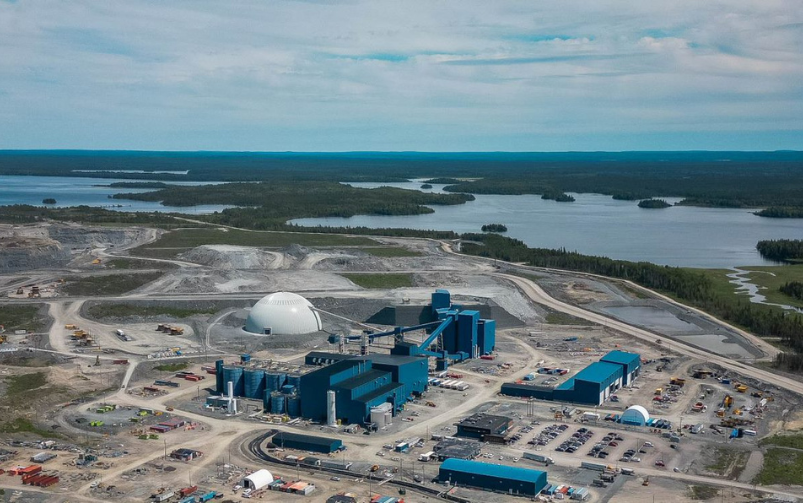Newmont’s Musselwhite mine in Ontario is one of the six mines being put up for sale by the company. Courtesy of The Government of Canada.
Welcome back to your weekly mining news recap, where we catch you up on some of the news you may have missed. This week’s headlines include FPX Nickel’s successful permanent carbon capture technology test, Agnico Eagle’s pilot project to onboard workers from its sister operations and First Quantum Minerals seeking US$20 billion from Panama following the forced closure of its Cobre Panama mine.
Newmont will be selling six mines along with two of its projects, turning its attention to focus on its 10 tier-one assets that are set to yield 6.7-million gold ounces by 2028, as reported by Engineering News. Newmont plans to divest its “non-core” assets, which include three Canadian mines—the Éléonore mine in Quebec, and the Musselwhite and Porcupine mines in Ontario—as well as its Cripple Creek and Victor mine in the U.S., its Akyem mine in Ghana, and its Telfer mine in Australia. It will also be selling its Havieron and Coffee projects, which are in Australia and Canada respectively.
Sayona Mining has released feasibility study results for its Moblan lithium project in Quebec, as reported by Engineering News. The project’s post-tax net present value is estimated to be $2.2 billion and the open-pit operation is expected to yield 300,000 tonnes of spodumene concentrate annually over a 21-year life of mine, with a lithium oxide grade of six per cent. The plant would have a processing capacity of 4,800 tonnes-per-day.
David Francis Lyon, founder and president of engineering company Zero Nexus, spoke about the gaps in specialized training needed to prepare the mining workforce for electrification at the one-day Battery Electric Vehicle Safety in Mines Symposium event last week in Sudbury. Lyon’s presentation outlined the results of a Zero Nexus qualitative research project, which identified the need to develop a collective base of knowledge on best practices for operationalizing BEVs.
First Quantum Minerals is aiming to secure US$20 billion through international arbitration after losing over half of its market value following Panama’s order to shut down its Cobre Panama copper mine, as reported by Reuters. The mine has been closed since late last year after Panama’s Supreme Court ruled that First Quantum Minerals’ contract with the government was unconstitutional, a move that followed months-long nationwide protests against the massive copper mine.
Agnico Eagle Mines recently employed 12 heavy-duty mechanics from Mexico to work at its Macassa mine in Ontario to help fill a demand for skilled labour, as reported by The Northern Miner. The hires are part of its new pilot program that aims to employ workers from the company’s sister operations. For Macassa, the workers were hired from Agnico’s La India mine in Mexico, which entered closure last year. The workers will start in the spring and will be placed on a permanent residency track, along with their families.
FPX Nickel Corp.’s subsidiary, CO2 Lock, announced it has successfully tested its permanent carbon capture and storage technology, as reported by Canadian Mining Journal. A thorough field program was conducted at its SAM site in B.C., which involved injecting CO2 into brucite-rich serpentinite rock, which liberated magnesium that then reacted with the CO2 to form stable carbonates. The company aims to extract a multi-tonne surface bulk sample from its site, which will be transported to CO2 Lock’s lab near Vancouver for further testing.
Four mining organizations are looking to merge their respective responsible mining codes and standards to form a single standard for the industry, as reported by Kelsey Rolfe in the February issue of CIM Magazine. The collaboration, led by ICMM, the Mining Association of Canada (MAC), Copper Mark and the World Gold Council, came about as a way to address feedback from investors, civil society, policymakers, downstream customers and other members of the mining industry, who all sought a single standard. The organizations will utilize the best elements of their respective standards to shape the foundation for a consolidated standard.
Although semi-autogenous grinding (SAG) is the most widely used comminution technique utilized at mineral processing plants, it comes with considerable obstacles, such as costly energy consumption and water scarcity, as reported by Graham Chandler in the December/January issue of CIM Magazine. In order to confront these challenges, some mining companies are turning to technologies that use artificial intelligence and machine learning in order to enable real-time prediction and optimization of mineral processing operations.
In the latest Mission Critical webinar hosted by CIM Magazine on Feb. 22, panelists shared some important insights on battery recycling and battery chemistry, as well as exploring how battery recycling could impact the future of the industry. A key focus in the webinar centred on how the industry can respond to the inevitable variability of battery chemistries. Niels Verbaan, director of technical services in metallurgy and consulting for SGS, shared an important distinction between end-of-life material and scrap material, noting that end-of-life material deals with chemistries that were produced roughly a decade prior, whereas scrap material involves the reprocessing of today’s chemistries.
We also have some year-end results and production results this week from companies with Canadian mining operations:
Osisko Gold Royalties announced that it had produced 94,323 ounces of gold equivalent for 2023.
Rio Tinto reported a free cash flow of US$7.7 billion for 2023, with underlying earnings reaching US$11.8 billion. Its net earnings amounted to US$10.06 billion, a decrease from 2022’s US$12.29 billion.
The Mosaic Company reported a steep decline in annual potash earnings, down to US$1.2 billion from US$2.8 billion in 2022. The company also said it will cut potash production from its Colonsay mine in Saskatchewan in response to market conditions.
Alamos Gold produced a total of 529,300 ounces of gold in 2023, a 15-per cent increase from the year prior, at an all-in sustaining cost (AISC) of US$1,160.
Pan American Silver Corp. produced 20.4 million ounces of silver at an AISC of US$18.17 per ounce. The company also produced 882,900 ounces of gold in 2023 at an AISC of US$1,113 per ounce.
Newmont Corporation produced a total of 5.5 million gold ounces at an AISC of US$1,444 per ounce. It also produced 891,000 gold equivalent ounces. It reported an adjusted EBITDA (earnings before interest, taxes, depreciation, and amortization) of US$4.2 billion for 2023.
Suncor Energy announced adjusted funds of $13.3 billion for its operations in 2023 and also record output from its oil sands operations, which yielded an average of 689,600 barrels per day.
Teck Resources announced an adjusted EBITDA of $6.4 billion for 2023.
Eldorado Gold Corp. produced 485,139 ounces of gold at an AISC of US$1,220 per ounce for 2023. The company reported an adjusted EBITDA of US$463.3 million for the year.
That’s all for this week. If you’ve got feedback, you can always reach us at editor@cim.org. If you’ve got something to add, why not join the conversation on our Facebook, Twitter, LinkedIn or Instagram pages?




